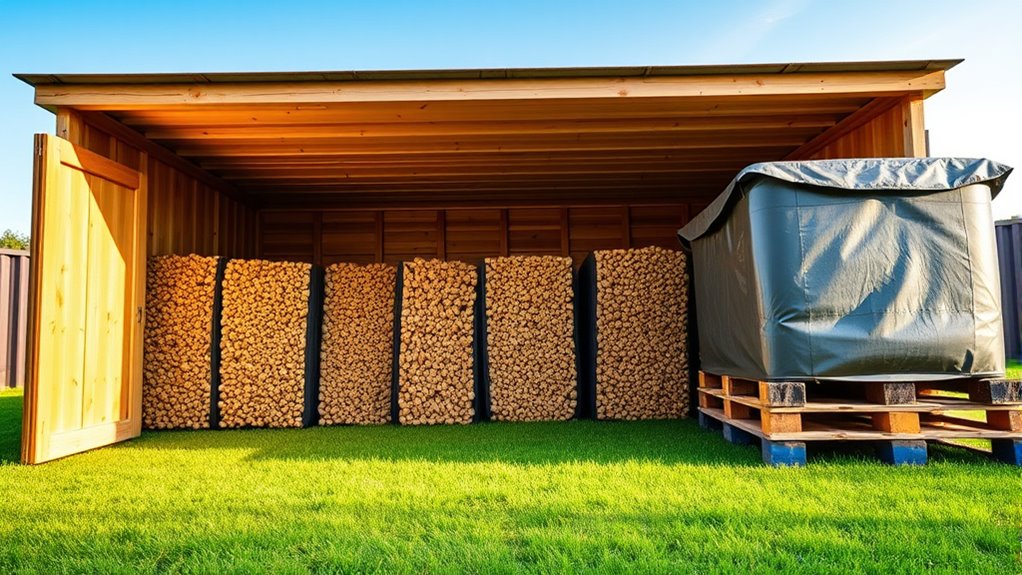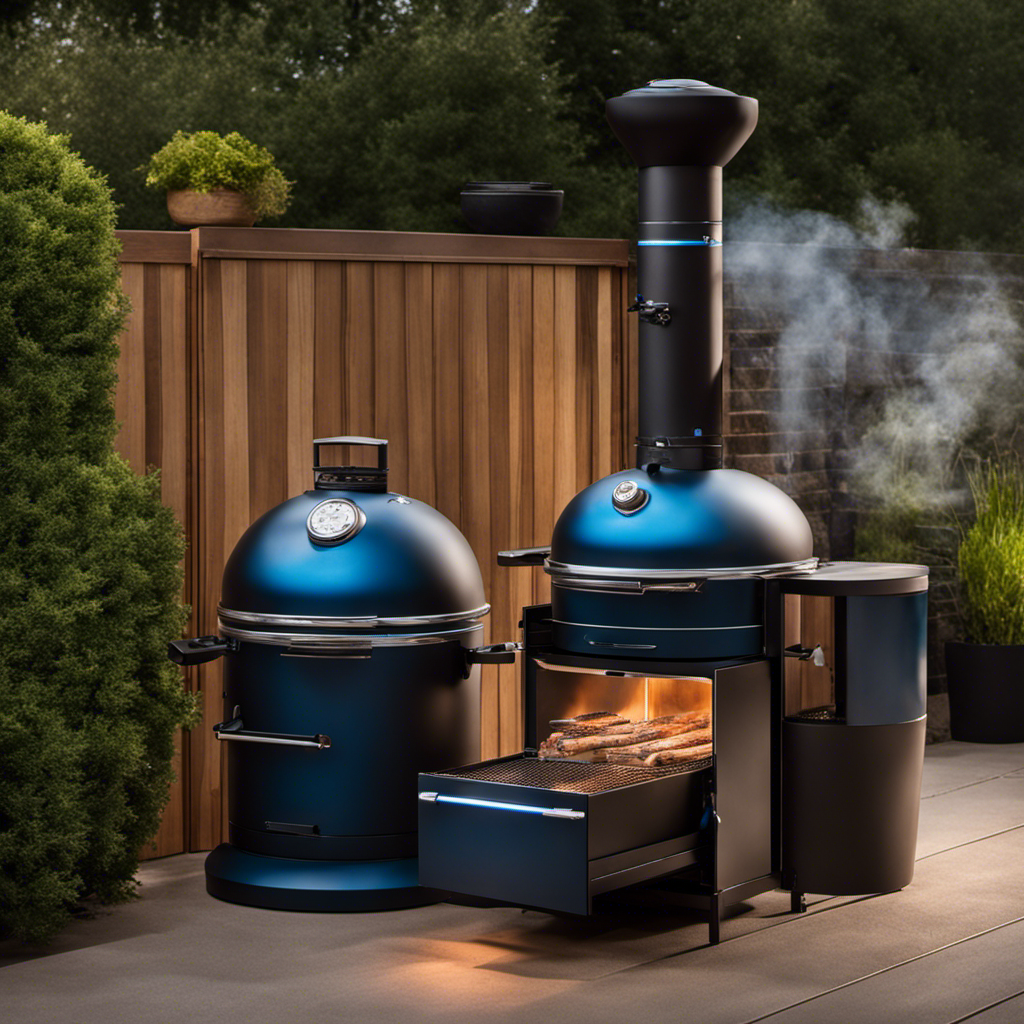To keep your wood pellets dry and ready, choose a cool, dry, well-ventilated location away from ground moisture and pests. Use weather-resistant containers and elevate storage units for airflow, and build a shelter with proper ventilation to prevent moisture buildup. Regularly inspect for pests, structural damage, and humidity issues. Maintaining these steps ensures your pellets stay high-quality and ready whenever you need them—learn more about suitable storage techniques to maximize your fuel’s lifespan.
Key Takeaways
- Choose a cool, dry, well-ventilated storage area away from moisture, pests, and direct sunlight.
- Use weather-resistant, airtight containers and elevate them on pallets to promote airflow.
- Maintain humidity below 15% with moisture barriers and regular moisture content checks.
- Ensure proper ventilation through vents or windows to prevent stagnant air and mold growth.
- Regularly inspect and clean storage structures, seals, and vents for pests, leaks, and structural integrity.
Choosing the Right Storage Location

Selecting the right storage location is essential to keep your wood pellets dry and maintain their quality. You need to take into account climate factors, such as humidity and temperature, which can cause moisture buildup and lead to mold or spoilage. Choose a spot that’s cool, dry, and well-ventilated to prevent condensation. Pest prevention is equally important; rodents and insects are attracted to wood pellets and can contaminate your supply. Store your pellets in a sealed container or an area less accessible to pests. Avoid outdoor sheds exposed to rain or direct sunlight, as these conditions increase moisture risk. Proper storage also involves secure containment, which helps in protecting your pellets from pests and environmental damage. Ensuring your storage area is well-ventilated can help reduce humidity and prevent mold growth. Additionally, selecting a climate-appropriate storage space can contribute significantly to preserving the quality of your wood pellets. By selecting a climate-appropriate, pest-proof location, you ensure your wood pellets stay dry, burn efficiently, and maintain their value for longer.
Preparing Your Storage Area

Before storing wood pellets, you need to prepare the area to guarantee it stays dry and pest-free. Start by selecting a well-ventilated space that’s protected from rain and ground moisture. Ensure the floor is level, clean, and made of a moisture-resistant material like concrete or sealed wood to aid moisture control. Seal any cracks or gaps that pests could use to enter. Keep the storage area free of debris and food sources that attract insects or rodents. Consider installing screens or barriers to prevent pest access. Maintain proper airflow to reduce humidity, which helps prevent mold and spoilage. Regularly inspect the area for signs of pest activity or moisture issues, and address problems immediately to keep your wood pellets in the best condition possible. Additionally, understanding the importance of a secure, well-maintained storage environment can significantly extend the quality and usability of your fuel supply. Proper ventilation systems are crucial to controlling humidity levels and ensuring the longevity of stored pellets. Installing moisture barriers can further protect your pellets from ground moisture and humidity infiltration. Implementing pest prevention measures can further safeguard your pellets from damage.
Using Proper Containers and Packaging

Using proper containers and packaging is essential to keep wood pellets dry and maintain their quality over time. Airtight containers prevent moisture from seeping in, which can cause mold and spoilage. If you prefer bagging, opt for weather-resistant packaging that shields pellets from rain and humidity during transport and storage. Such packaging helps preserve the pellets’ integrity, ensuring they stay dry and burn efficiently. Avoid flimsy or porous bags that allow air and moisture to penetrate. Using durable, sealed containers or weather-resistant packaging not only protects your investment but also reduces waste and maintains the pellets’ energy content. Proper packaging is a simple yet effective way to ensure your wood pellets remain in optimal condition until you’re ready to use them. Additionally, selecting containers with appropriate ventilation can help prevent condensation build-up inside, further protecting your fuel. Incorporating proper storage techniques can significantly extend the shelf life of your pellets and ensure consistent performance.
Building a Covered Shelter

When building a covered shelter for your wood pellets, choose durable materials that can withstand weather over time. Make sure your design includes proper ventilation to keep moisture out and prevent spoilage. This way, your pellets stay dry and ready to use whenever you need them.
Selecting Durable Materials
Choosing sturdy materials is vital for building a covered shelter that protects your wood pellets effectively. You want to use weather resistant materials that can withstand rain, snow, and sun exposure over time. Opt for sturdy, long-lasting options like pressure-treated wood, metal, or high-quality plastic that won’t warp or rot. Durable containers are also essential if you plan to store pellets temporarily inside the shelter. They prevent moisture from seeping in and keep your fuel dry. When selecting materials, prioritize those designed for outdoor use and resist the elements. This guarantees your shelter remains strong and reliable, keeping your wood pellets protected from moisture and temperature fluctuations. Incorporating weather-resistant materials ensures the longevity of your storage solution and maintains the quality of your fuel. Additionally, considering moisture barriers can further enhance protection against humidity and leaks. Using corrosion-resistant hardware can prevent rust and deterioration of your shelter’s structure, ensuring it stays durable over time. Investing in the right durable materials guarantees your storage solution will last and maintain the fire safety of your fuel storage area. Moreover, selecting materials with easy maintenance properties can simplify upkeep and prolong the lifespan of your shelter.
Designing Proper Ventilation
Proper ventilation plays a key role in maintaining the quality of your wood pellets inside a covered shelter. Effective airflow management helps prevent moisture buildup, which can cause mold and spoilage. To guarantee proper moisture control, design your shelter with vents positioned to promote continuous air circulation. Avoid stagnant air pockets by installing adjustable vents or windows that can be opened or closed as needed. Elevate the shelter off the ground to improve airflow underneath and reduce humidity exposure. Keep vents clean and unobstructed, especially during wet seasons. Good ventilation balances air exchange without letting in excessive moisture or drafts. Incorporating ventilation principles ensures optimal moisture control and preserves the quality of your fuel. Additionally, paying attention to humidity levels within the shelter can further prevent deterioration of your wood pellets. Regularly monitoring airflow patterns can help identify and correct any issues that may lead to moisture accumulation. Properly managing air circulation is essential for long-term storage and fuel efficiency.
Elevating Your Pellets for Better Ventilation
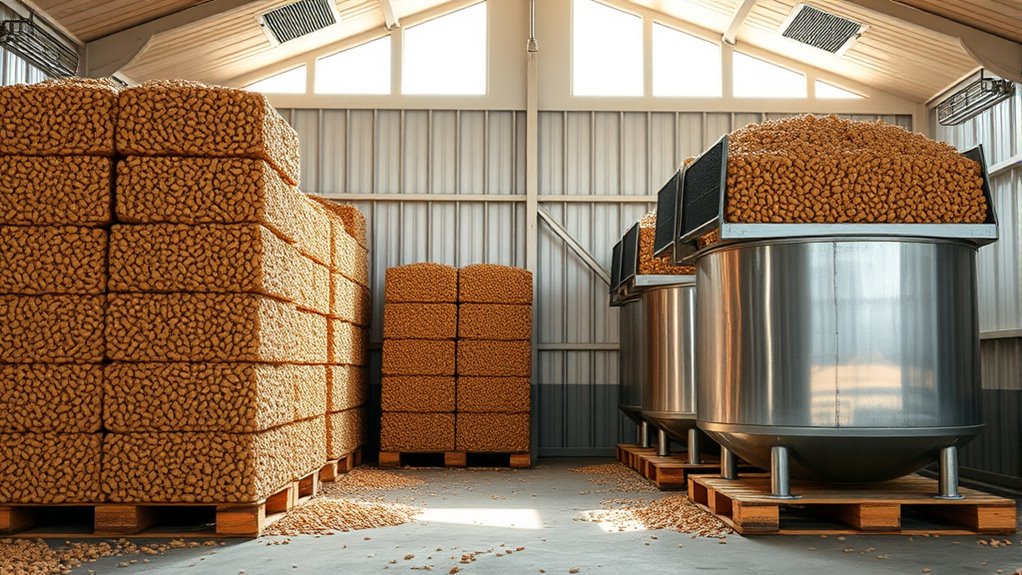
Elevating your wood pellets off the ground is essential for ensuring proper airflow and preventing moisture buildup. When you lift the pellets, you promote better air circulation around the storage area, which helps keep them dry and reduces the risk of mold or decay. Using pallets, racks, or platforms creates a gap underneath your storage container, allowing air to flow freely beneath the pellets. This improved ventilation helps control moisture levels, ensuring your fuel stays dry and ready to burn. Proper elevation also minimizes contact with ground moisture, which can cause deterioration of the pellets. Additionally, understanding Proper Storage Techniques can help you implement effective storage solutions and troubleshoot common issues. Maintaining good ventilation is vital for preventing moisture accumulation, which can compromise the quality of your wood pellets over time.
Managing Humidity Levels

Controlling humidity levels is crucial to keeping your wood pellets in ideal condition. Excess moisture can cause mold, clumping, and reduce burning efficiency. To prevent this, maintain proper humidity control and moisture prevention strategies. Store pellets in a dry, covered area, and consider using moisture barriers like plastic sheeting or airtight containers. Use a hygrometer to monitor humidity levels regularly. Keep the storage environment below 15% moisture content to avoid clumping and spoilage. Proper storage practices are essential to extend the lifespan of your fuel. Incorporating advanced moisture detection techniques can further enhance your control over storage conditions, especially as modern heat pumps incorporate humidity control features that can assist in maintaining optimal indoor environments.
Ensuring Good Airflow Around the Storage Site
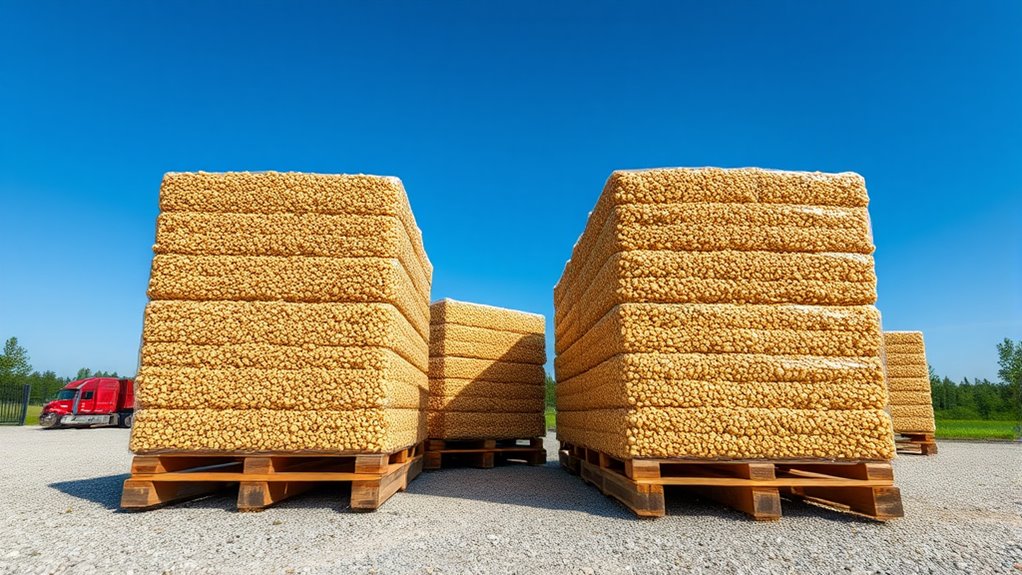
Make sure there’s enough space around your wood pellet storage to allow for proper airflow. Avoid placing the pellets where vents or fans could be blocked, as restricted airflow can cause moisture buildup. Keeping clear pathways helps your pellets stay dry and maintain their quality.
Adequate Ventilation Space
To prevent moisture buildup and reduce the risk of mold or spontaneous combustion, you need to make certain there’s adequate airflow around your wood pellet storage. Ensuring proper air circulation helps maintain consistent moisture control, keeping your pellets dry and ready for use. Leave enough space around your storage container or pile so air can freely flow on all sides. Avoid tight enclosures or overcrowded areas, which trap humidity and hinder ventilation. Using pallets or supports elevates the storage off the ground, promoting better airflow underneath. Regularly inspect the area for blockages or debris that might restrict airflow. Good ventilation not only preserves the quality of your pellets but also minimizes safety hazards associated with moisture and heat buildup. Implementing vertical storage solutions can further enhance airflow and maximize space efficiency.
Avoid Blocked Airflow
Blocked airflow can quickly lead to moisture buildup and heat accumulation, so maintaining clear pathways around your wood pellet storage is vital. Proper airflow helps with moisture control and prevents airflow obstruction, which can cause mold and spoilage. To guarantee good airflow:
- Keep the storage area elevated on a pallet or platform.
- Maintain at least 12 inches of clearance on all sides.
- Avoid stacking pellets too tightly, allowing air to circulate.
- Regularly inspect for debris or obstructions that may block vents or pathways.
Regular Inspection and Maintenance
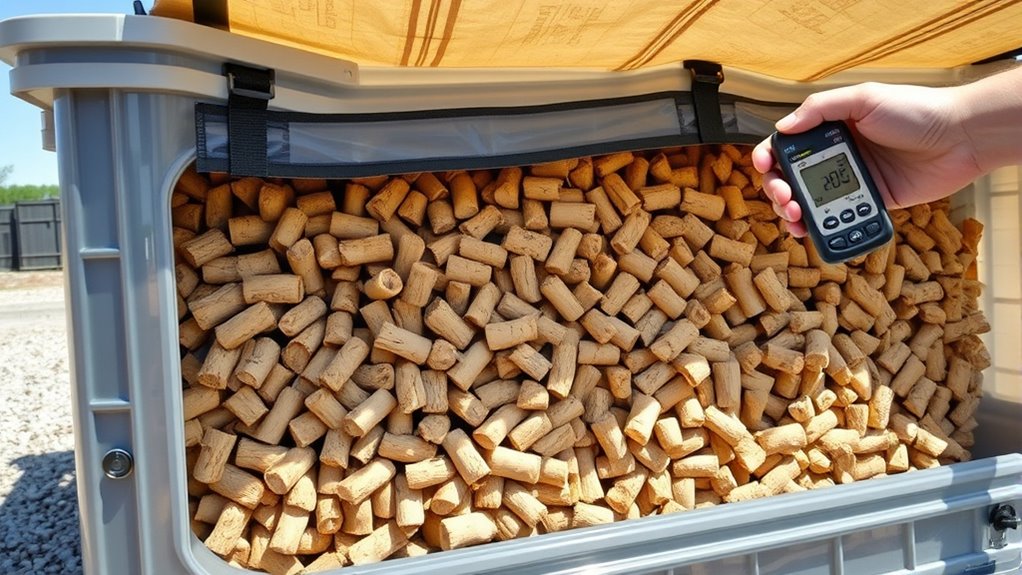
Regular inspection and maintenance are essential to guarantee your wood pellet storage remains in good condition and your pellets stay dry and accessible. Establish an inspection routine to check for signs of moisture, pests, or damage to the storage structure. Regularly verify seals, vents, and the integrity of the container to prevent leaks or airflow issues. Adhering to a maintenance schedule helps you catch problems early, such as mold growth or structural wear. Clean out any debris or dust buildup that could compromise airflow or attract pests. By staying proactive, you ensure your storage stays in prime condition, protecting your pellets and maintaining their quality. Consistent inspections and timely maintenance are key to reliable, efficient storage that keeps your fuel dry and ready whenever you need it.
Handling and Replenishing Your Stock

Handling and replenishing your wood pellet stock correctly guarantees your supply remains reliable and maintains its quality. To do this effectively:
Proper handling and replenishment ensure your wood pellet supply stays reliable and high-quality.
- Regularly check moisture levels to prevent mold and keep pellets dry.
- Keep your storage area clean and well-ventilated to deter pests.
- When adding new pellets, mix them gently with existing stock to ensure even moisture distribution.
- Use sealed containers or covers during replenishment to prevent moisture intrusion and pest entry.
Tips for Long-Term Storage Success

To guarantee your wood pellets stay in top condition over the long term, focus on maintaining a stable, dry environment and protecting them from pests. Moisture control is key—store pellets in a sealed, airtight container or a well-ventilated shed to prevent humidity from causing mold or spoilage. Regularly inspect your storage area for leaks or dampness, and consider using desiccants if necessary. Pest prevention is equally important; keep the storage area clean, elevate containers off the ground, and seal all openings to deter insects and rodents. Proper airflow helps reduce moisture buildup, while secure containers prevent pests from accessing your fuel. By following these tips, you’ll ensure your wood pellets stay dry, fresh, and ready whenever you need them.
Frequently Asked Questions
How Can I Detect Mold or Spoilage in Stored Pellets?
To detect mold or spoilage in your stored pellets, start with a visual inspection; look for any discoloration, clumping, or unusual textures. Use moisture indicators to check if the pellets have absorbed excess moisture, which promotes mold growth. If you notice a musty smell or see visible mold, it’s best to discard the affected pellets. Regularly inspecting and monitoring moisture levels helps keep your fuel dry and safe to use.
What Are the Best Practices for Pest Prevention in Pellet Storage?
To prevent pests in pellet storage, you should focus on insect prevention and rodent control. Keep your storage area clean and dry, as pests thrive in damp conditions. Seal any gaps or holes to block entry points, and consider using pest deterrents or traps. Regularly inspect your pellets and storage space, and make certain proper ventilation. These practices help keep your fuel pest-free and ready for use whenever you need it.
How Do Temperature Fluctuations Affect Pellet Quality?
Temperature fluctuations can harm your pellet quality by causing humidity changes that lead to condensation inside storage. When temperatures drop, moisture can build up, reducing the pellets’ energy content and causing mold or degradation. To prevent this, you should focus on humidity control and condensation prevention by keeping your storage environment stable and well-ventilated. This way, your pellets stay dry, maintain their quality, and are ready when you need them.
Can I Mix Old and New Pellets Safely?
You can mix old and new pellets, but it’s best to practice storage segregation to prevent quality issues. Pellet mixing may cause inconsistent burn and ash production if the old pellets have absorbed moisture or deteriorated. To keep your fuel efficient, combine only pellets stored in similar conditions and verify they’re dry. Regularly check your stock and separate fresh from older pellets for ideal performance and safety.
What Are Environmentally Friendly Options for Storing Pellets?
Think of eco-friendly storage options as a gust of fresh air for your pellets. You can choose biodegradable containers and eco-friendly packaging that protect your fuel while caring for the environment. These options break down naturally, reducing waste and pollution. By selecting sustainable storage methods, you not only keep your pellets dry and ready but also contribute to a healthier planet. It’s a small change with a big impact.
Conclusion
By following these tips, you’ll keep your wood pellets perfectly dry and ready whenever you need them—turning your storage into a fortress against moisture and spoilage. With careful preparation and regular maintenance, your fuel stash can last for years without losing its quality, making your heating season smoother than ever. Think of your storage as the ultimate vault, preserving your pellets like precious treasure—because when it comes to your fuel, nothing should stand in your way!

